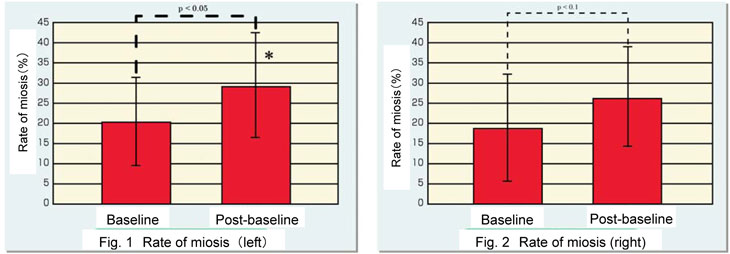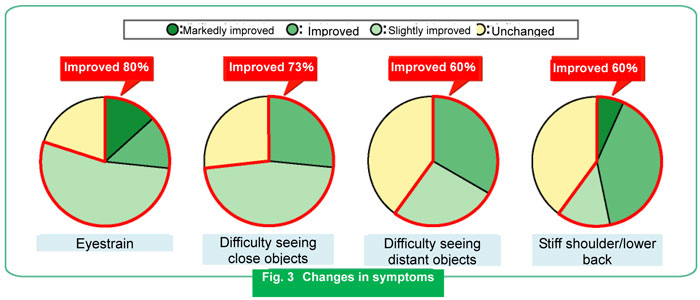- TOP
- List of reports
- Effects of Tablets Containing Astaxanthin and Crocetin on Asthenopia and Accommodation
Effects of Tablets Containing Astaxanthin and Crocetin on Asthenopia and Accommodation
【Scientific information】
Research and Development Department, Sun Chlorella Corporation
Effects of Tablets Containing Astaxanthin and Crocetin on Asthenopia and Accommodation
Presented at the 11th Annual Meeting of Japanese Society for Complementary and Alternative Medicine (2008)
- Study Objectives
- Recently, asthenopia due to VDT1) and depression of ocular accommodation associated with aging have become medically concerned issues. According to a report by the Ministry of Health, Labour and Welfare in 2002, 78% of VDT workers complained of physical fatigue and other symptoms, and as many as 91% of them suffered from "strain of and pain in the eyes". In addition, with the increase of ageing population, the number of people with asthenopia due to presbyopia has been increasing. Many clinical reports have suggested that astaxanthin improves asthenopia and ciliary fatigue, and also increases the rate of miosis2). Crocetin also reportedly improves ciliary fatigue and improves blood flow. In this background, we investigated the effects of tablets containing astaxanthin and crocetin on symptoms of asthenopia and depression of ocular accommodation, especially near-pupil responses in middle-aged and older men.
- Method and experiments
- The study was conducted in 15 middle-aged and older men, aged from 45 to 65 years, who complained of asthenopia. The subjects ingested 10 tablets containing astaxanthin and crocetin (investigational food) after dinner for 28 days. At the screening visit 7 days before the start of the study (Day -7) and on Day 28, the subjects underwent medical examination by interview, self-administration questionnaire on symptoms, and measurement of visual acuity, refractive power, and rate of miosis, which was determined using the TriIRIS C-9000 near-pupil response measuring system.
- Results
- The rate of miosis increased from baseline in both eyes after the ingestion of the investigational food. That of the left eye was 20.2±10.9% at baseline and 29.2±12.8% on Day 28; this difference was statistically significant (Figs. 1 and 2).
- In the questionnaire on symptoms, 80%, 73%, 60%, and 60% of subjects indicated that "eyestrain," "difficulty seeing close objects," "difficulty seeing distant objects", and "stiff shoulder/lower back" had improved, respectively (Fig. 3).
- Our findings suggest the following possibilities concerning the effects of tablets containing astaxanthin and crocetin in middle-aged and older men.
- 1.Increasing the rate of miosis leads to improve the pupillary movement.
2.Improving the symptoms associated with asthenopia and presbyopia.


Terminology
- Note 1) VDT
- The Visual Display Terminal (VDT) is a device with a display screen (e.g., computer display,screen on a mobile phone, or screen on a portable game).
- Note 2) Rate of miosis
- Seeing of close objects involves adjustment of lens thickness by the ciliary muscle and contraction of the pupil (miosis) by the pupillary sphincter muscle, which enable formation of a clear image. The rate of miosis represents the degree of pupillary contraction, by which ocular accommodation can be numerically evaluated.
Presentation at a scientific meeting
- Name of meeting:
- The 11th Japanese Society for Complementary and Alternative Medicine Academic Meeting (2008)
- Title:
- Effects of astaxanthin-crocetin-containing foods on asthenopia and ocular accommodation
- Presenters:
- Yukari Arakawa, Masaki Fujishima, and Toru Mizoguchi
- Affiliation:
- Sun Chlorella Corporation





